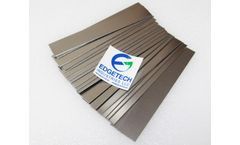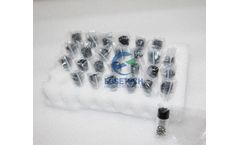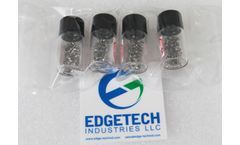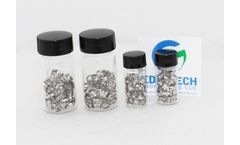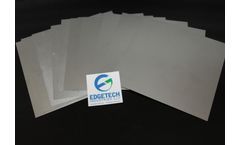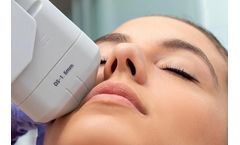Medical Implant Articles & Analysis
22 articles found
At Edgetech Industries, we specialize in supplying high-quality Nitinol sheets engineered for demanding industrial applications across aerospace, medical, and robotics fields. But what exactly is a Nitinol sheet, and why is it being adopted at such a rapid pace? ...
Precision and Accuracy: The Role of Platinum Iridium Marker Bands in Medical Procedures" Precision and accuracy are crucial aspects in medical procedures such as radiation therapy. ...
These small yet essential components ensure visibility, precise positioning, and contribute to the success of medical implants and device placement procedures. Tantalum is a biocompatible metal with excellent radiopacity, making it an ideal material for medical marker bands. The benefits of using tantalum radiopaque marker bands are numerous ...
Research Hotspots in Hydroxyapatite l Biomedical Applications Hydroxyapatite's compatibility with the human body has made it a staple in medical applications. It is widely used in bone grafts, dental implants, and coatings for orthopedic devices. ...
ByMatexcel
Precision and Accuracy: The Role of Platinum Iridium Marker Bands in Medical Procedures" Precision and accuracy are crucial aspects in medical procedures such as radiation therapy. ...
Polyaryletherketones (PAEKs) These include PEEK, PEK, and PEKK, all known for their strength, heat resistance, and ability to maintain performance under stress. PAEKs are used in medical implants, aerospace components, and high-performance industrial parts. 4. ...
What is biofilm? Biofilms are defined as communities of micro-organisms attached to a surface, or one another, and encased within a matrix of extracellular polymeric substance (EPS). The EPS makes up the largest component of the biofilm, and in the biological environment is generally composed of polysaccharides, proteins, glycolipids, blood products, cellular debris, extracellular enzymes, metal ...
This growth is propelled by their extensive use in sectors such as construction, automotive, electronics, medical, and personal care. Key Drivers of Silicone Market Growth Construction Industry: The demand for silicone in the construction industry is rising due to its application in sealants, adhesives, and coatings. ...
It offers good printability, high strength, and biocompatibility, making it suitable for medical devices, prosthetics, and anatomical models. What is Metal 3D Printing Materials? ...
In biomedical engineering, hydrophobic polymers are used in the development of medical devices, implants, and drug delivery systems. Their water-repellent properties help prevent bacterial adhesion, ensuring the safety and efficacy of these devices. ...
What makes Nitinol even more fascinating is its ability to "remember" its shape, which can be programmed and modified for endless applications ranging from medical implants to aerospace engineering. Without a doubt, Nitinol is a game-changer in the world of materials science, paving the way for innovations beyond our wildest imaginations. ...
Food & Drug Administration (FDA) quotes the International Medical Device Regulatory Forum’s definition: "software intended to be used for one or more medical purposes that perform these purposes without being part of a hardware medical device." ...
Titanium and its alloys have many advantages as surgical implant materials, such as low density, high strength, good toughness, good biocompatibility, non-toxicity, low elastic modulus, good corrosion resistance, and low X-ray absorption rate Etc., thus occupying an increasingly important position in medical metal materials. ...
Nitinol can make the magic shop spoon bend in hot water also because of its shape memory function Nitinol's superelasticity and biocompatibility make it an ideal choice for manufacturing a variety of medical devices implanted in the human body. For example, a stent is a device that supports blood vessels and keeps them open. Nitinol's superelasticity can compress ...
The research of atmospheric plasma’s use for medical treatments has gathered apace over recent years. Plasma comprises charged particles as well as a range of other active components that are thought to interact with the body to produce desired affects in plasma medicine such as; electric current, UV radiation and reactive gas species these components are thought to be ...
Close to the core of medical device performance are PTFE tubing and FEP sheets, both of which offers a huge array of medical sector applications. ...
“With this expansion into polymers for textile-based medical devices, Evonik continues to strengthen its position as a preferred global partner for medical device companies. ...
Magnetic resonance imaging (MRI) is a frequently used diagnostic imaging modality that may be an alternative to other types of radiologic imaging (e.g., computerized tomography, nuclear medicine imaging). It can detect soft tissue characteristics (e.g., inflammation), and because magnetic resonance (MR) uses a magnetic field and radio waves to produce images, it does not expose patients to ...
Medical Implant Manufacturer Succeeds with Customized Air Pollution Control Equipment Many industries utilize silicone as an ingredient in their manufactured product. ...
Electrohydrodynamic spraying has recently emerged as a powerful method of producing nano-structured hydroxyapatite (nHA) coatings for biomedical implants. To enhance the mechanical properties of these coatings, a subsequent heat treatment is normally needed. ...

